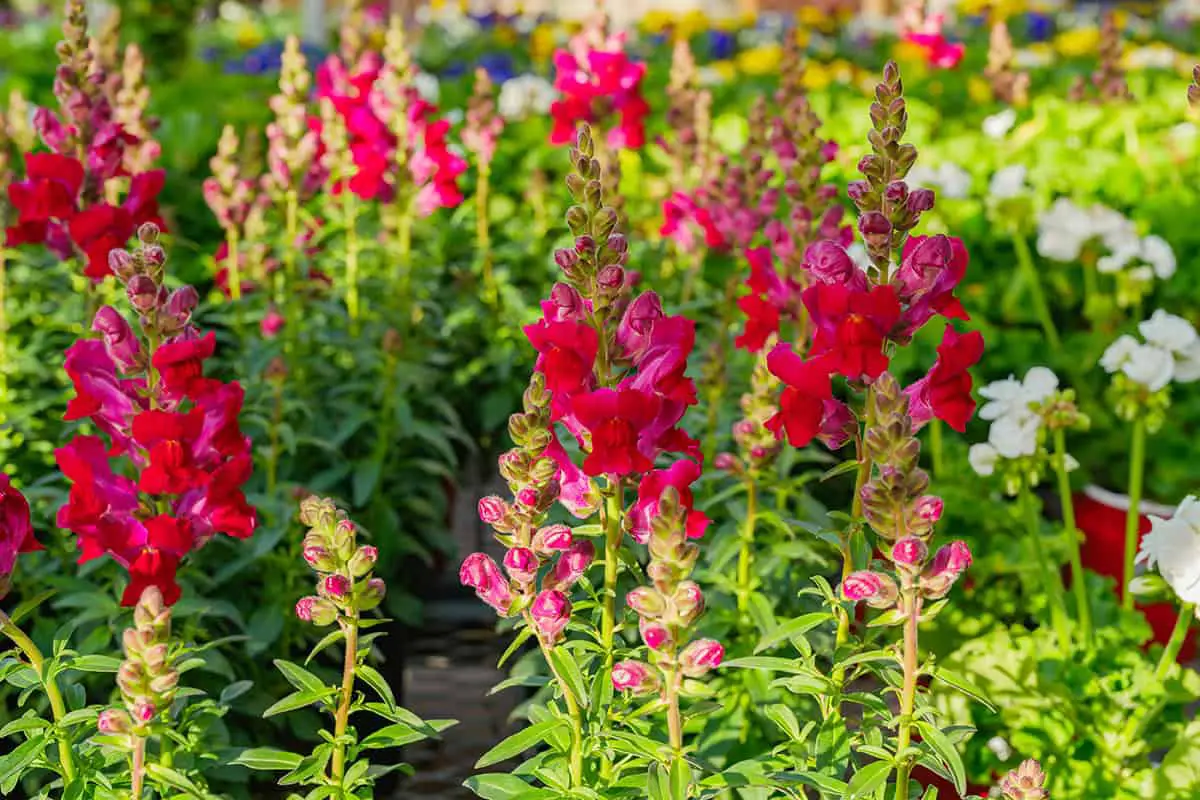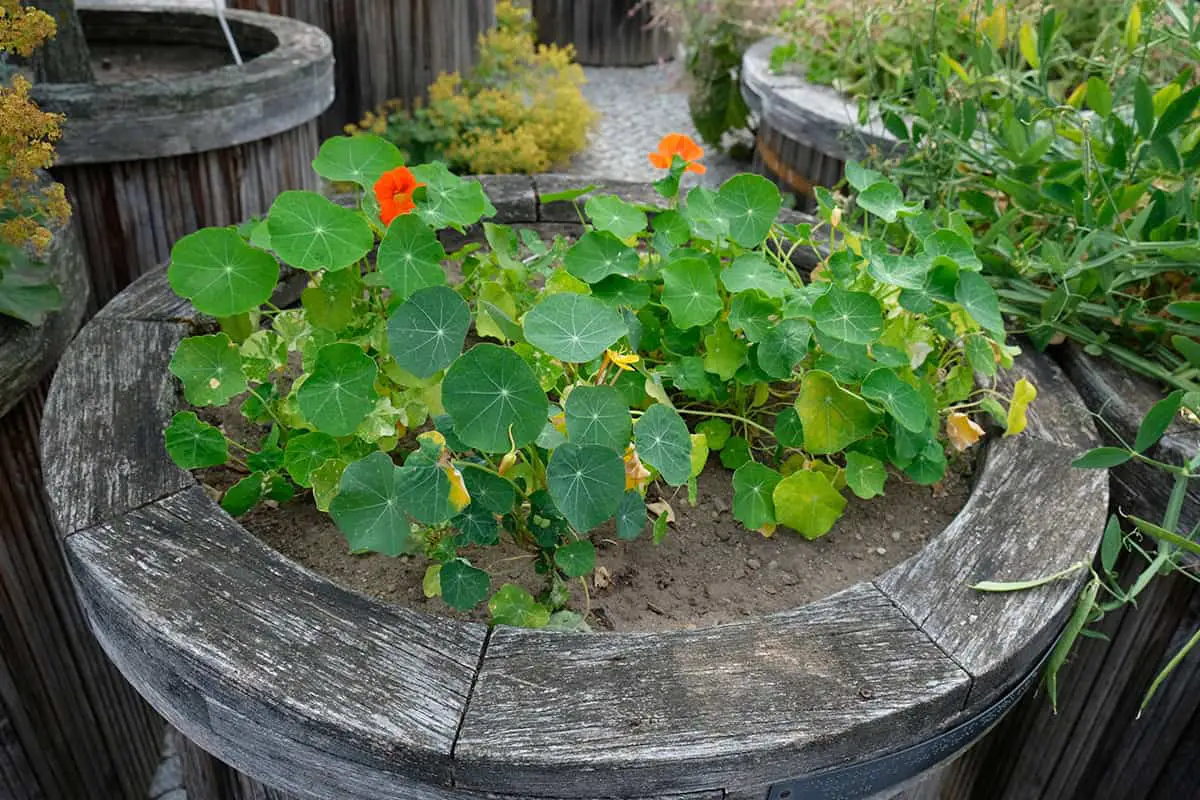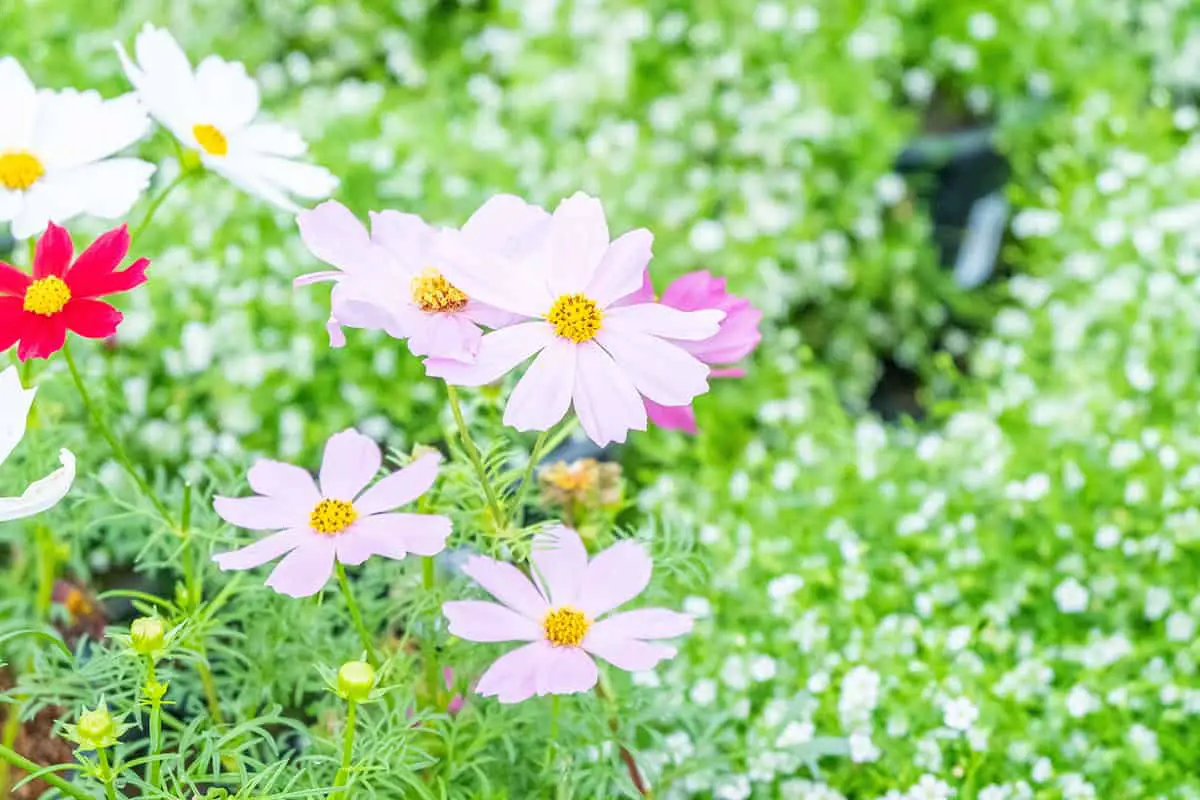You step out onto your patio, hoping to enjoy a burst of color, but the space feels dull and uninviting. Adding potted flowers can instantly brighten your patio and create a more welcoming atmosphere. Learn about the best-potted flowers for your patio to transform it into a vibrant and beautiful outdoor space.
Table of Contents
Petunias

Petunias add vibrant color to your patio. These flowers thrive in full sun and need well-drained, moist soil. Make sure to position them where they can bask in sunlight for most of the day. Containers should allow for effective drainage to prevent root rot.
For best results, water your petunias with around 1 to 2 inches every week. This approach encourages deep-root growth. Avoid light, and frequent watering to prevent shallow roots. Ensure your petunias are spaced correctly. Space them 12 to 18 inches apart for ideal growth and airflow.
Petunias come in a dazzling array of colors. They can brighten any space with hues from delicate pastels to deep purples. They bloom from spring until frost, offering long-lasting decoration. Choose a variety like the Easy Wave Rose Fusion petunia for a touch of elegance.
Temperature matters for these flowers. Keep day temperatures near 65°F and night temperatures between 55°F and 65°F. During early growth, a fluorescent light can aid their development. If using a fluorescent light, place your petunias 4 to 6 inches below the fixture until they’re ready for outdoor planting.
Geraniums

Geraniums brighten up your patio with vibrant colors. These potted flowers are perfect for outdoor spaces. They are adaptable and can thrive in various conditions. You’ll find them in shades of red, pink, orange, white, and purple.
They require well-drained soil to grow healthily. Place them where they can get at least six hours of sunlight daily. Geraniums can tolerate some shade but bloom best with ample sun. Regular watering keeps the soil moist, not soggy.
To ensure they flourish, deadhead spent blooms regularly. This encourages new growth and more flowers. During the growing season, feed them with a balanced fertilizer every two weeks. Without proper nutrients, your geraniums may not perform well.
As the season changes, geraniums continue to impress. They can be overwintered indoors, ensuring year-round enjoyment. A sunny window will suffice to keep the plants alive until spring.
Begonias

Begonias serve as vibrant additions to your patio. They flourish in pots, adding color and life to your outdoor space. With their lush foliage and diverse flower colors, begonias are a delightful choice for any gardener.
These plants prefer shaded areas, safeguarding their delicate blooms from direct sunlight. You’ll find they thrive with consistent moisture and well-draining soil. Regular watering keeps your begonias lush, but take care to avoid waterlogged conditions.
Choose from several varieties that bring a range of sizes and colors to your patio. The cascading types are perfect for hanging baskets, gracing your space with their overhanging blossoms. Compact types fit well on tables or shelves, making them versatile for any layout.
Impatiens

Impatiens make your patio vibrant. With their bright flowers, they thrive in shaded spots. You can choose from colors like white, pink, and red to personalize your space. They suit containers well, making them ideal for your patio.
Caring for impatiens is straightforward. They need fertile, well-drained soil and regular watering. Make sure to protect them from the cold, planting only after frost risks pass. These flowers often become a patio highlight. Impatiens bloom from late spring to the first frost, ensuring a long season of color. Check varieties like Impatiens Walleriana for common selections.
Impatiens are versatile. They work both as standalone plants and in arrangements. For a lush look, mix colors and plant densely.
Marigolds

Marigolds offer vibrant colors to your patio with their robust orange and yellow blooms. You can enjoy their full sun-loving nature in well-drained, loamy soil. They thrive in pots, making them perfect for patio life. Their hardiness and low maintenance cater to both novice and experienced gardeners.
Choosing marigolds for your patio brings a continuous splash of color, as these flowers typically bloom from early summer until the first frost. With varieties like the petite French marigold or the larger African marigold, you have options to fit planters of any size. The French marigold is compact, and perfect for small pots, while the African marigold boasts taller growth and larger flowers for a dramatic effect.
To plant marigolds, ensure your pots have proper drainage. Incorporate organic matter into your soil to nourish your flowers. Remember, marigolds need full sun to flourish. Place your pots where they can bask in daylight. Regular deadheading will keep them blooming vigorously.
Pests tend to avoid marigolds, another reason to add them to your patio garden. Your marigolds can help deter unwanted insects, offering a natural form of pest control.
Fuchsias

Fuchsias add a vibrant splash of color to your patio with their pendulous blooms. You’ll find these flowers striking and suitable for hanging baskets. Many gardeners cherish fuchsias for their variety of colors and graceful, balletic shapes. Originating from the mountainous regions of South America, fuchsias thrive in cooler temperatures and partial shade.
To keep your fuchsias flourishing, provide them with well-drained soil and consistent moisture. These plants dislike drying out, so regular watering is essential. But be careful not to overwater, as this can lead to root rot. Fuchsias enjoy morning sun and afternoon shade, making them perfect companions for a patio setting where direct sunlight can be controlled.
When planting fuchsias, choose a spot on your patio that meets their light requirements. Ensure the pot you select has adequate drainage holes. Fertilization is vital for the continuous blooming of fuchsias; a balanced, water-soluble fertilizer every couple of weeks should do the trick.
Lavender

When choosing potted flowers for your patio, consider lavender. This plant is not only beautiful but also fragrant. Lavender thrives in pots where you control the soil type and drainage. What you gain is a natural mosquito repellent and a fresh scent.
For lavender to flourish, ensure your pot has adequate drainage holes. Use a light, well-draining soil mixture to prevent waterlogged roots. Lavender loves the sun, so place your pot in a spot that receives plenty of sunlight. Ideally, aim for full sun exposure for at least 6 hours a day.
Remember to water your lavender correctly. Your approach should be infrequent yet thorough watering. Allow the soil to dry out before watering again. Over-watering can lead to root rot, which is detrimental to your lavender. During the growing season, you might add a balanced, slow-release fertilizer to encourage growth.
Pruning is essential for keeping lavender in shape. Prune in the spring or after flowering. Trim off about one-third of the top growth. Proper pruning prevents your plant from becoming too woody and helps maintain a compact form.
Snapdragons

Snapdragons add a vibrant touch to your patio with their tall flower spikes and varied colors. These blossoms range from shades of pink to deep reds, sunny yellows, and crisp whites. They can also display colorful bicolor patterns. You’ll find that snapdragons are a good fit for outdoor containers due to their vertical growth and bright hues.
These plants can thrive across different climates, but they are perennial in warmer zones such as USDA hardiness zones 9 or above. In slightly cooler zones, they might still live for several years with proper care. Snapdragons prefer full sun to partial shade and require well-draining soil. Regular watering keeps them moist but be sure to avoid waterlogging.
To keep your snapdragons blooming, deadheading is key. This process involves removing faded flowers and encouraging new blooms to form. For ongoing health and vigor, feed your snapdragons with a balanced fertilizer, such as a 20-20-20 formula, monthly during their growing season.
Consider pairing these flowers with other cool-season plants that enjoy similar growing conditions. By doing so, you create a diverse and flourishing display on your patio.
Pansies

Pansies add vibrant color to your patio. They thrive in cooler temperatures, ideally between 40°F at night and 60°F during the day. You can find them in a multitude of colors, from deep purples to sunny yellows.
Choosing your pansies involves picking healthy plants in 3-inch or 4-inch pots. Larger pots usually indicate a stronger root system.
To care for your pansies, place them in a south-facing spot for optimum flowering. Ensure they are well-watered and fertilized, and use a cover for protection in harsh temperatures.
Pansies are resilient and can bloom all winter with proper care, especially Icicle® pansies, which are bred for cold weather.
Use a high-quality container mix for your pansies. Watering them before freezing weather helps keep them hydrated and healthy.
Sunflowers

Sunflowers brighten your patio with their vibrant colors. You can easily grow them in pots, as they need full sun to thrive and well-drained soil. Make sure to choose a variety suitable for containers; dwarf types work best.
To plant sunflowers, you need a large pot with drainage holes. Plant the seeds 1 to 2 inches deep and keep the soil moist but not soggy. Sunflowers grow quickly and can reach full size in just a few months. For continuous blooms, plant seeds at intervals.
Nasturtiums

Nasturtiums brighten your patio with vibrant colors. You can grow these annuals easily in pots, and they require minimal care. Their leaves and flowers are edible, adding a peppery zest to your salads.
Choose a sunny spot for your nasturtiums. These flowers thrive in well-drained soil and moderate water. Regular deadheading promotes more blooms, so you’ll enjoy a succession of red, orange, and yellow flowers throughout the growing season.
Protect your nasturtiums from frost. In cooler climates, they may die back in winter, but you can always plant new seeds in spring. Ensure your pots have good drainage to prevent root rot.
Dahlias

Dahlias brighten your patio with their vivid colors and striking forms. These flowers thrive in pots, making them ideal for spaces large or small. They offer a variety of shapes and sizes, from the petite to the grandiose. You can select from an extensive color palette that includes pinks, yellows, reds, and even bicolors.
To grow dahlias on your patio, choose a pot with drainage holes. Fill it with a mixture of potting soil and compost for the best results. Place the pot in a spot that gets six to eight hours of sunlight each day. This ensures your dahlias get enough light to bloom well.
Water your dahlias regularly to keep the soil moist but not soggy. Overwatering can lead to root rot, so careful monitoring is key. Fertilize monthly with a water-soluble flower formula to promote healthy growth and blooming.
Remember to deadhead spent blooms. This encourages more flowers to grow and extends the blooming period. Dahlias start flowering in early summer and can continue blooming until the first frost.
Calibrachoa

Calibrachoa plants are ideal for your patio pots. They resemble petunias but produce smaller, bell-shaped flowers. You’ll find them in a wide range of colors. For success with calibrachoa, select a well-drained potting mix.
These plants thrive in full sun to part shade, so ensure they receive at least six hours of sunlight daily. Adequate light keeps calibrachoa blooming profusely. Fertilize them every two to three weeks during the growing season.
Regular watering is key to vibrant calibrachoa. However, avoid waterlogging as this can lead to root rot. If the foliage looks wilted or flowers diminish, check your watering routine.
Pruning is not often necessary, but if your calibrachoa becomes leggy, a light trim can encourage bushier growth.
Coleus

Coleus, with its vibrant foliage, is an excellent choice for patio decoration. These plants feature leaves in a range of colors including green, yellow, pink, red, and maroon. You can use them in containers to provide a splash of color.
Coleus thrives in both sun and shade varieties. However, the intensity of the leaf color develops best with adequate lighting. For brighter leaves, place your coleus in a spot with indirect sunlight.
Coleus prefers evenly moist soil, so ensure you water them regularly. But be cautious not to overwater, as coleus does not like to sit in waterlogged soil.
Their maintenance is minimal, which makes coleus suitable for gardeners of all levels. These plants are known for their durability and few problems with pests. Enjoy their vivid beauty with little worry.
Coleus works well in hanging baskets, stand-alone pots, or as part of a mixed display. You have a variety of choices when it comes to designing your patio space with these colorful plants.
Zinnias

Zinnias brighten your patio with vivid colors. They are hardy flowers, ideal for pots, and you can easily grow them in small spaces. Their blooms offer a splash of color from spring to frost.
These plants require minimal care, so ensure they receive six or more hours of sunlight daily. Water them when the soil feels dry to the touch. Zinnia’s bright petals attract butterflies, creating a lively atmosphere.
Choose from various Zinnia sizes for your pots. Dwarf varieties fit well in confined spaces, while taller types can grow more than a foot high. For a dramatic effect, try taller types.
Remember to place zinnias in a spot with good air circulation. This helps prevent mildew, and cutting the flowers encourages further blooming.
Salvia

Salvia is ideal for your patio as it can thrive in pots. This flowering plant comes in many varieties, offering you a range of colors. You find red, purple, and blue flowers common among salvias. They require well-drained soil and are somewhat drought-tolerant, so you won’t need to worry much about frequent watering.
With salvias on your patio, you create an inviting space for hummingbirds and pollinators. These plants boast blooms that last from late spring through frost in some regions. Ensure your salvia gets full to partial sun for vigorous growth.
When you plant salvias, space them properly, as they need room to grow. Typically, they need about 24 to 36 inches of space to allow for adequate air circulation. Place them in a spot that receives at least six hours of sunlight each day.
For the best care, water your potted salvia before you remove it from the nursery pot. Dig a hole in the soil about twice the width of the pot, then plant your salvia at the same depth it was in the container.
Gazanias

Gazanias thrive on your patio as potted flowers. Originating from southern Africa, they are hardy plants with striking daisy-like blooms. Their colorful flowers can greatly enhance your outdoor living space, as each flower dazzles in shades of orange, yellow, white, or red.
You can easily maintain gazanias in containers, as they need full sunlight and well-draining soil to flourish. With minimal care, these flowers will produce large, vibrant blooms. Water them sparingly, as they are drought-resistant.
In the right conditions, gazanias create a stunning display. They are perfect for patio décor because of their tolerance for heat and sunlight. Their trailing stems can also add a touch of elegance to hanging baskets.
To ensure lasting beauty, remove spent flowers, as this will encourage further blooming throughout the season.
Tulips

Tulips enhance your patio with vibrant colors and elegant shapes. These bulbs flourish in pots, adding a structured look to any outdoor space. Your choice of tulip variety can lead to a display that lasts from early to late spring.
For successful growth, use well-draining soil and ensure the pots have drainage holes. Plant tulips in the fall for robust spring blooms. A sunny position is best for these cheerful flowers, and you’ll find tulips in nearly every shade, from classic reds to pastel hues.
Proper care involves regular watering and rotating the pots. This keeps stalks straight as they reach for the light, so avoid overwatering to prevent bulb rot. After blooms fade, allow the foliage to die back naturally, as this process feeds the bulbs for the next season.
Consider mixing different tulip types for a prolonged flowering period. Early bloomers like ‘Fosteriana’ give way to mid-season ‘Darwin Hybrids’ and finally to late-season ‘Viridiflora’.
Hydrangeas

Hydrangeas enhance your patio with vivid blooms and lush foliage. These plants flourish in well-draining soil and benefit from consistent moisture. To encourage vibrant flower colors, adjust your soil’s pH. Acidic soil yields blue flowers, while alkaline soil promotes pink hues.
Hydrangeas prefer bright, indirect light and temperatures between 60 to 65°F. Protect them from harsh afternoon sun, which can scorch their leaves.
Keep the soil evenly moist, and water your hydrangeas when the top inch of soil feels dry. Avoid overwatering, which can lead to root rot.
Prune your hydrangeas after they bloom to maintain shape and size. Remove only the dead and old branches, as pruning encourages new growth and more blooms in the following season.
Cosmos

Cosmos makes an excellent choice for your patio. If you desire potted flowers that are both vibrant and easy to care for, consider these blossoms. They can enhance your outdoor space with their variety of colors.
To begin, select a container with sufficient drainage. This step is crucial to prevent water from becoming stagnant at the roots.
Plant cosmos in a soil mix rich in organic matter. They thrive with regular watering and plenty of sunlight. Aim to place your pots where they will receive at least half a day of sun. Regular deadheading encourages more blooms to form.
These flowers attract butterflies, adding another layer of beauty to your patio. Because of their aroma and structure, Cosmos is a captivating presence. To keep them upright, staking may be necessary for taller varieties.
During the growing season, Cosmos can grow quite rapidly. Ensure they have enough room to flourish in their pots. For continuous beauty, you may want to plant them in succession. This way, when one batch is past its prime, another is reaching its full potential.






